

Increasing Inclusivity in the Classroom. Print Version by Andrew Greer, Graduate Teaching Fellow The goals of this teaching guide are threefold: 1) to discuss the importance of inclusivity in the classroom, 2) to present examples of teaching more inclusively, and 3) to provide additional resources for further guidance.

Why is inclusivity important? Drawing from the literature on inclusive teaching in higher education, the current section considers the importance of increasing inclusivity and is framed by two overarching issues. The first issue is that of student belonging in their classrooms and in the broader campus culture. The 25 most popular icebreaker questions based on four years of data. If you winced at the word, “icebreaker,” I don’t blame you.

Get-to-know-you questions and games tend to feel cheesy. We’ve all been victim to a terribly trite icebreaker with coworkers that made us roll our eyes. The How and Why of Trauma-Informed Teaching. Working with trauma-affected students is a difficult balancing act. We acknowledge the harmful impacts of the past, and hold out hope for a future of healing. We create a safe environment for students to share their lives, yet maintain professional boundaries. Assessment for Equity. How Mastery Checks Can Elevate Learning in Your Classroom ‹ Flipped Learning Review. – Dan Jones – This past week, my 8th-grade students took their first mastery check, focused on the French explorers who had come to the Americas.
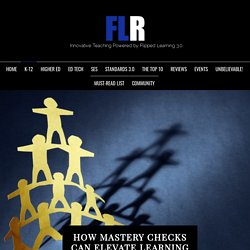
It should have been a fairly straightforward examination of their understanding of the content; after all, the students only had to study two explorers. My students had watched two instructional videos, one on each explorer, and I made sure that both videos were under five minutes. Each student had taken notes, but the result was…only one out of 18 passed the mastery check. Did I do something wrong? The truth is, the mastery check was exactly what was needed! Providing students with material using best-practices was not all that was needed to ensure mastery of the content; more workmanship was required. I began my school year on an assumption. Patrice Bain also explored the concept of retrieval. Amy C. What are best practices for designing group projects? - Eberly Center.
What is true for individual assignments holds true for group assignments: it is important to clearly articulate your objectives, explicitly define the task, clarify your expectations, model high-quality work, and communicate performance criteria.
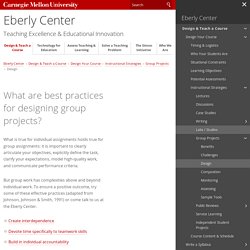
But group work has complexities above and beyond individual work. To ensure a positive outcome, try some of these effective practices (adapted from Johnson, Johnson & Smith, 1991) or come talk to us at the Eberly Center. Create interdependence While some instructors don’t mind if students divvy up tasks and work separately, others expect a higher degree of collaboration. If collaboration is your goal, structure the project so that students are dependent on one another. Devote time specifically to teamwork skills. Two Times Ten Conversations. Pedagogy Unbound. Interactive presentation software. Tips for Creating a Participatory Classroom Environment - Faculty Focus. All too often students shuffle into class, take notes while the professor lectures for 50 minutes or so, and then pack up and leave.
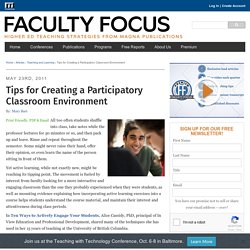
Rinse and repeat throughout the semester. Some might never raise their hand, offer their opinion, or even learn the name of the person sitting in front of them. Yet active learning, while not exactly new, might be reaching its tipping point. The movement is fueled by interest from faculty looking for a more interactive and engaging classroom than the one they probably experienced when they were students, as well as mounting evidence explaining how incorporating active learning exercises into a course helps students understand the course material, and maintain their interest and attentiveness during class periods.
In Ten Ways to Actively Engage Your Students, Alice Cassidy, PhD, principal of In View Education and Professional Development, shared many of the techniques she has used in her 15 years of teaching at the University of British Columbia. CTE - Collaborative Learning. What is collaborative learning?
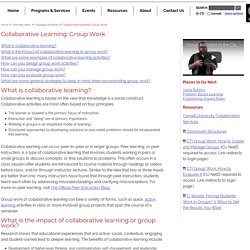
What is the impact of collaborative learning or group work? What are some examples of collaborative learning activities? A Brief Summary of the Best Practices in College Teaching. Intended to Challenge the Professional Development of All Teachers Compiled by Tom Drummond North Seattle Community College Introduction/Overview: I have collected here, without examples or detailed explanations, a collection of practices that constitute excellence in college teaching.
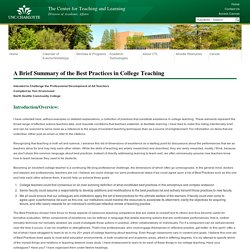
These elements represent the broad range of effective actions teachers take, and requisite conditions that teachers establish, to facilitate learning. How to Link to a YouTube Video, or Embed a YouTube Video into URCourses. 170 Ways To Use Word Clouds In Every Classroom. Once again, I am amazed every time I talk to groups and find out so many educators have not used word clouds with their students.
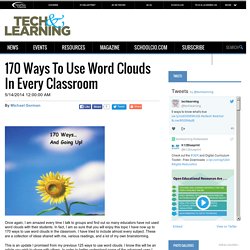
In fact, I am so sure that you will enjoy this topic I have now up to 170 ways to use word clouds in the classroom. I have tried to include almost every subject. These are a collection of ideas shared with me, various readings, and a lot of my own brainstorming. This is an update I promised from my previous 125 ways to use word clouds. I know this will be an article you wish to share with others. All Subjects Put your lesson plan into a word cloud to create a word cloud of what you will be learning about.